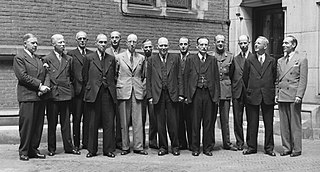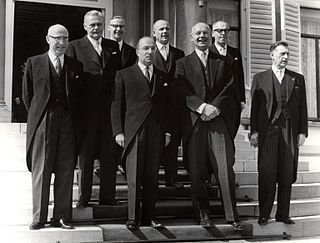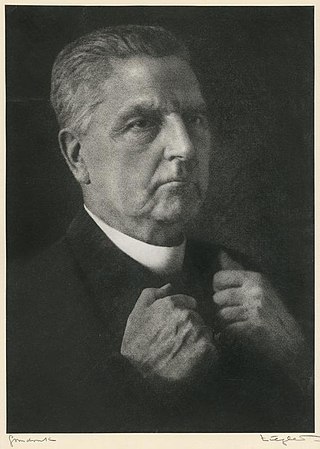
The Nolens Doctrine is a principle in politics of the Netherlands that Catholics should only collaborate with the Social Democratic Workers' Party (SDAP) in the cabinet in cases of "utmost necessity."

The Nolens Doctrine is a principle in politics of the Netherlands that Catholics should only collaborate with the Social Democratic Workers' Party (SDAP) in the cabinet in cases of "utmost necessity."
The doctrine refers to the leader of the General League of Roman Catholic Caucuses, Willem Hubert Nolens. He articulated this principle in 1922 after the League's board sought to forbid cooperation. Nolens' aim was not to exclude collaboration with the social democrats but rather to leave the door slightly open. Towards the end of the interwar period, the doctrine lost its significance as the rise of fascism and the economic crisis led the SDAP to adopt a more responsible stance, removing several ideological obstacles. This resulted in the formation of the second De Geer cabinet in August 1939, which included both the SDAP and the League's successor, the Roman Catholic State Party (RKSP). [1]
After World War II, the phrase "utmost necessity" was often referenced when the successor of the KVP, the Catholic People's Party (KVP), did or did not form a coalition with the successor of the SDAP, the Labour Party (PvdA). Political scientist Hans Daudt formalized this into a theory in 1980 (also known as the Daudt doctrine), but it is generally rejected within political science. [2]
The Labour Party is a social democratic political party in the Netherlands.

The Christian Democratic Appeal is a Christian democratic and conservative political party in the Netherlands.

The Anti-Revolutionary Party was a Protestant conservative and Christian democratic political party in the Netherlands. The party was founded in 1879 by Abraham Kuyper, a neo-Calvinist theologian and minister who served as Prime Minister between 1901 and 1905. In 1980 the party merged with the Catholic People's Party (KVP) and the Christian Historical Union (CHU) to form the Christian Democratic Appeal (CDA).

The Catholic People's Party was a Catholic Christian democratic political party in the Netherlands. The party was founded in 1945 as a continuation of the interwar Roman Catholic State Party, which was in turn a successor of the General League of Roman Catholic Caucuses. The party was in government throughout its existence. In 1977, a federation of parties including the Catholic People's Party, the Anti-Revolutionary Party (ARP) and the Christian Historical Union (CHU) ran together under the Christian Democratic Appeal (CDA) banner. The three participating parties formally dissolved to form the CDA in 1980.

The Free-thinking Democratic League was a progressive liberal political party in the Netherlands. Established in 1901, it played a relatively large role in Dutch politics, supplying one Prime Minister, Wim Schermerhorn. The League is a predecessor of two of the major Dutch political parties, the conservative liberal People's Party for Freedom and Democracy (VVD) and the social democratic Labour Party (PvdA). The social liberal Democrats 66 also claims that it and the VDB are ideologically connected.

The Christian Historical Union was a Protestant Christian democratic political party in the Netherlands. The CHU is one of the predecessors of the Christian Democratic Appeal (CDA), into which it merged in September 1980.

The Schermerhorn–Drees cabinet was the executive branch of the Dutch Government from 25 June 1945 until 3 July 1946. The cabinet was formed by the christian-democratic Roman Catholic State Party (RKSP), the social-democratic Social Democratic Workers' Party (SDAP) and the social-liberal Free-thinking Democratic League (VDB) by royal decree following the end of World War II. The cabinet was a provisional centre-left grand coalition and had a substantial majority in the House of Representatives, with prominent civil engineer Willem Schermerhorn of the Free-thinking Democratic League serving as Prime Minister. Social Democratic Leader Willem Drees served as Deputy Prime Minister and Minister of Social Affairs.

The first Van Agt cabinet, also called the Van Agt–Wiegel cabinet was the executive branch of the Dutch Government from 19 December 1977 until 11 September 1981. The cabinet was formed by the christian-democratic Christian Democratic Appeal (CDA) and the conservative-liberal People's Party for Freedom and Democracy (VVD) after the election of 1977. The cabinet was a centre-right coalition and had a slim majority in the House of Representatives with Christian Democratic Leader Dries van Agt serving as Prime Minister. Liberal Leader Hans Wiegel served as Deputy Prime Minister and Minister of the Interior.

The Den Uyl cabinet was the executive branch of the Dutch Government from 11 May 1973 until 19 December 1977. The cabinet was formed by the social-democratic Labour Party (PvdA), the christian-democratic Catholic People's Party (KVP) and Anti-Revolutionary Party (ARP), the progressive Political Party of Radicals (PPR) and the social-liberal Democrats 66 (D'66) after the election of 1972. The cabinet was a Centre-left grand coalition and had a substantial majority in the House of Representatives with Labour Leader Joop den Uyl serving as Prime Minister. Prominent Catholic politician Dries van Agt, the Minister of Justice from the previous cabinet, served as Deputy Prime Minister until his resignation. Prominent Protestant politician Gaius de Gaay Fortman the Minister of the Interior assumed the office of Deputy Prime Minister on 8 September 1977.

The De Jong cabinet was the executive branch of the Dutch Government from 5 April 1967 until 6 July 1971. The cabinet was formed by the christian-democratic Catholic People's Party (KVP), Anti-Revolutionary Party (ARP) and Christian Historical Union (CHU) and the conservative-liberal People's Party for Freedom and Democracy (VVD) after the election of 1967. The cabinet was a centre-right coalition and had a substantial majority in the House of Representatives with prominent Catholic politician Piet de Jong the Minister of Defence in the previous cabinet serving as Prime Minister. Prominent Liberal politician Johan Witteveen a former Minister of Finances served as Deputy Prime Minister and returned as Minister of Finance, prominent Protestant politician Joop Bakker the Minister of Economic Affairs in the previous cabinet served as Deputy Prime Minister, Minister of Transport and Water Management and was given the portfolio of Suriname and Netherlands Antilles Affairs.

The Roman Catholic State Party was a Catholic Christian democratic political party in the Netherlands. The party was founded in 1926 as a continuation of the General League of Roman Catholic Electoral Associations. During its entire existence, the party was in government. In 1945 the party became the Catholic People's Party (KVP).

The Social Democratic Workers' Party was a Dutch socialist political party existing from 1894 to 1946. Originating from a split in the prior Social Democratic League, the party was a predecessor of the current social democratic Labour Party (Netherlands).

The Cals cabinet was the executive branch of the Dutch Government from 14 April 1965 until 22 November 1966. The cabinet was formed by the christian-democratic Catholic People's Party (KVP) and Anti-Revolutionary Party (ARP) and the social-democratic Labour Party (PvdA) after the fall of the previous Cabinet Marijnen. The cabinet was a Centre-left coalition and had a substantial majority in the House of Representatives; prominent Catholic politician Jo Cals, a former Minister of Education, served as Prime Minister. Labour Leader Anne Vondeling served as Deputy Prime Minister and Minister of Finance, Protestant Leader Barend Biesheuvel continued as Deputy Prime Minister, Minister of Agriculture and Fisheries and the responsibility for Suriname and Netherlands Antilles Affairs from previous cabinet.

Petrus Josephus Mattheus "Piet" Aalberse Sr. was a Dutch politician of the General League of Roman Catholic Electoral Associations, later the Roman Catholic State Party (RKSP) and later co-founder of the Catholic People's Party (KVP) and jurist. He was granted the honorary title of Minister of State on 31 December 1934.

This article gives an overview of Christian democracy in the Netherlands, which is also called confessionalism, including political Catholicism and Protestantism.
Roman/Red is the nickname for a period in Dutch politics between approximately 1945 and 1958. This period was characterized by coalitions between the Catholic and social-democratic parties in the Netherlands and Belgium. "Roman" refers to the parties with Roman Catholic affiliation, and "red" refers to the colour associated with social democrats. During the Roman/Red period, the Catholic People's Party (KVP) and the social-democratic Labour Party (PvdA) formed the core of several 'Roman/Red' cabinets, led primarily by Willem Drees.

Wilhelmus Hubertus "Wiel" Nolens was a Dutch politician and a Roman Catholic priest.

Adolf Marcus "Dolf" Joekes was a Dutch politician and diplomat of the Free-thinking Democratic League (VDB) and later co-founder of the Labour Party (PvdA) and businessman.

The Red Week was a period from 9 to 14 November 1918 when socialist revolution was anticipated in the Netherlands. The Red Week anticipation stemmed from the end of the First World War and revolutions elsewhere in Europe.

A process of cabinet formation took place following the Dutch general election on 16 May 1946. This resulted in the formation of the First Beel cabinet on 3 July 1946. The coalition was formed by the Catholic People's Party (KVP) and the Labour Party (PvdA).